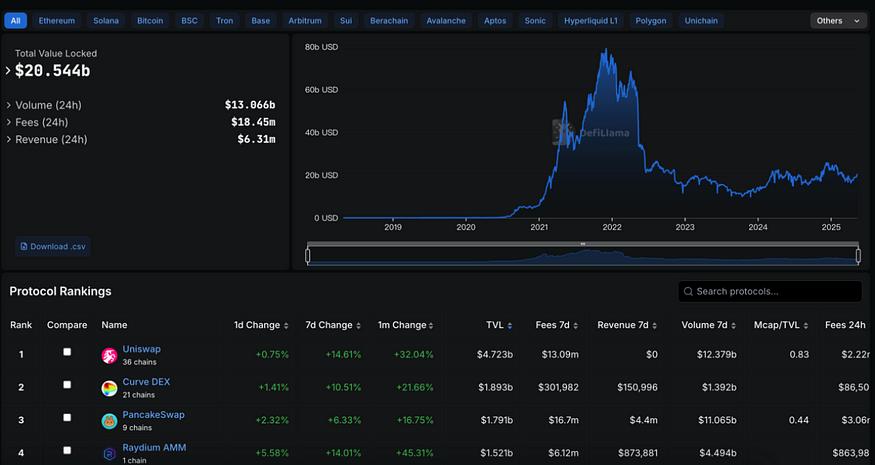Author: Trend Research
Since Trend Research's research report was released network-wide on April 24, 2025, ETH has risen from $1,800 to around $2,400, an increase of about 30% in one month. The prediction before writing the report started at $1,450, and as a trillion-scale asset target, it is a rare opportunity for large funds to achieve high returns in the short term. The main reasons for firmly being bullish at that time include: ETH still has robust financial data, and its position as a critical crypto infrastructure remains unchanged; the massive adjustment at the short-term high point (over 60% decline in 4 months); the massive short position in the derivatives market, rising after the bottom spot volume to the important support and resistance exchange area, continuous layout of traditional finance, and gradual ETF inflow. Currently, our prediction for ETH is that we believe it can break through $5,000 in the long term, and in an optimistic scenario, if BTC rises to over $300,000 in this cycle, ETH is expected to rise to $10,000, and we will continue to capture opportunities related to the ETH ecosystem.
I. ETH Valuation Forecast
An important background for the new valuation of ETH is capturing the convergence trend between key digital assets and traditional finance. We have noticed that BTC, as the most important digital asset, after passing the spot ETF, has opened the prelude to being incorporated into the strategic reserve assets by various US states, gradually becoming a scale expansion of dollar assets and a certain degree of strategic alternative, currently ranking 6th in global asset market value. The US BTC spot ETF currently manages approximately $118.6 billion in assets, accounting for about 6% of Bitcoin's total market value. The integration trend of crypto assets with traditional finance is beyond doubt. CZ stated in an interview in Dubai in May that Bitcoin's price in this market cycle could reach $500,000 to $1 million.

ETH still maintains robust financial data, and its position as the most important infrastructure in crypto finance remains unchanged. Ethereum's DeFi total TVL is around $60 billion, accounting for 53%+ of the global DeFi market, with a stablecoin market value of $124 billion, accounting for 50%+ of the global stablecoin total market value. The total AUM of Ethereum ETF is $7.2 billion, with BlackRock's tokenized money market fund BUIDL having an investment scale of approximately $2.7 billion in the Ethereum ecosystem, accounting for 92% of its total assets.

ETH experienced three tops at $4,000 in 2024 before quickly falling to around $1,300, with an ATH of over $4,800. Based on the following potential factors, we predict that ETH's price will reach $5,000 in this cycle:
- The imminent end of US QT and further interest rate cuts
- The new SEC chairman may bring breakthroughs in ETH on-chain token and staking-related bills
- ETH Foundation's management and route repair, maintaining a certain degree of infrastructure innovation
- Maintaining a robust on-chain financial ecosystem
In a long-term optimistic prediction, ETH is expected to challenge $10,000 in the new cycle, which requires the following conditions:
- BTC rises to over $300,000
- ETH brings eye-catching infrastructure innovations favorable to DeFi
- US institutions promote ETH as an important native platform for asset tokenization
- Demonstration effect driving global asset tokenization
II. Three Unmissable ETH Ecosystem Projects
1. UNI (Uniswap): The Largest DEX Protocol in the Crypto Market
Uniswap is the earliest and largest Dex protocol in the crypto market, with a TVL of $4.7 billion, daily trading volume exceeding $2 billion, generating $900 million in revenue annually. UNI is fully circulated, with about 40% locked for governance, current circulating market value of $4 billion, and FDV of $6.6 billion.

Currently, there is a certain decoupling between UNI's token economics and protocol revenue. The protocol's generated revenue is not automatically distributed to UNI token holders. UNI primarily serves as a governance token, allowing voting to control the treasury's use, and can indirectly positively affect UNI's price through governance proposals, such as the DAO voting to repurchase 10 million UNI in 2024.
The decoupling between protocol revenue and token revenue is mainly due to previous SEC regulatory risks regarding security classification. With the gradual relaxation and standardization of US crypto regulation, UNI's protocol distribution may have upgrade possibilities in the future.
Recent Uniswap developments include Uniswap V4 and Unichain expansion, and the preliminary activation of the "Fee Switch" mechanism.
2. AAVE (Aave): The Largest Lending Protocol in the Crypto Market
AAVE is the largest lending protocol in the crypto market, with a TVL of $23 billion, generating $450 million in revenue annually, 100% token circulation, and a current market value of $3.3 billion.

Similar to UNI, there is no direct dividend relationship between protocol revenue and AAVE, but it indirectly influences through governance.
Recent Aave developments include Aave V4 development, cross-chain expansion of native stablecoin GHO, and advancing the Horizon project to explore RWA business.
3. ENA (Ethena): The Largest Synthetic Stablecoin Protocol in the Crypto Market
From 2025 to date, Ethena's synthetic dollar USDe has become the third-largest dollar-pegged asset in the crypto market, only behind USDT and USDC, and the only synthetic stablecoin. In terms of revenue, Ethena is also a high-yield DeFi protocol, generating $315 million in revenue annually. ENA currently has a market value of $2.18 billion, with an FDV of $5.6 billion.

Recent Ethena business developments include: Ethena will collaborate with Securitize to launch the "Converge" blockchain network, aiming to bridge traditional finance and DeFi; plan to launch a stablecoin product iUSDe for traditional financial institutions; integrate its stablecoin sUSDe into Telegram applications; and build an ecosystem based on its stablecoin sUSDe, including a perpetual and spot exchange Ethereal on its own application chain and an on-chain options and structured product protocol Derive.








